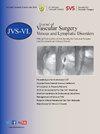Pigmentation after foam or cryo-laser cryo-sclerotherapy for lower limb reticular veins: A within-patient randomized trial
IF 2.8
2区 医学
Q2 PERIPHERAL VASCULAR DISEASE
Journal of vascular surgery. Venous and lymphatic disorders
Pub Date : 2025-07-11
DOI:10.1016/j.jvsv.2025.102285
引用次数: 0
Abstract
Objective
Skin hyperpigmentation is a common complication after leg vein sclerotherapy and a primary concern for patients with cosmetic complaints. The aim of this study was to determine if cryo-laser cryo-sclerotherapy technique (CLaCS) presents a lower incidence and intensity pigmentation after procedure compared with 0.5% polidocanol foam sclerotherapy, 60 days after a single treatment of reticular veins.
Methods
This was an open-label, prospective, within-patient, randomized, active controlled, safety trial with blind evaluators. Interventions took place from August through September 2021, with a 2-month follow-up. Interventions were performed in a private clinic. Eligible patients were volunteers over 18 years old, with aesthetic discomfort related to bilateral lower limb reticular veins, similar length and distribution, with veins' internal diameter up to 2.2 mm in B-mode ultrasound. Patients underwent consecutive CLaCS treatment in one limb and 0.5% polidocanol foam in the contralateral limb on the same day. The primary outcome was the presence of post-procedure pigmentation in treated areas 60 days after a single treatment, determined through photo evaluation and objective measurement of skin color dissimilarity between the treated area and the adjacent skin, using a precision colorimeter. Patients’ aesthetic satisfaction improvement, vein diameter reduction, and minor/major adverse events were also assessed.
Results
Twenty-three women (46 limbs) were treated, and two were lost to follow-up. No significant statistical difference in the number of limbs that developed posttreatment pigmentation was found for both photo (7 CLaCS vs 5 foam; P = .8906) and colorimetric (9 CLaCS vs 13 foam; P = .1445) evaluations. The CLaCS group had significantly lower intensity of pigmentation in colorimetry (mean ΔE of 1.30 for CLaCS vs 1.44 for foam; P = .02735). No significant difference in veins’ diameter reduction was found. Both groups presented substantial improvement in patients’ satisfaction with their leg appearance.
Conclusions
Although no statistical difference was found regarding the number of limbs that developed hypercromia after treatment of the reticular veins, CLaCS resulted in a lower intensity of skin color dissimilarity, less microthrombi formation and drainage, less bruising and lower volume of sclerosant needed, without difference in diameter reduction rates, compared with polidocanol foam sclerotherapy. No major adverse events were reported.
泡沫或冷冻激光冷冻硬化治疗下肢网状静脉后的色素沉着:一项患者试验。
重要性:皮肤色素沉着是腿部静脉硬化治疗后的常见并发症,也是美容投诉患者的主要关注点。目的:确定冷冻激光冷冻硬化治疗技术(CLaCS)在网状静脉单次治疗后60天,与0.5%聚多醇泡沫硬化治疗相比,是否出现了更低的发生率和强度的色素沉着。设计:开放标签,前瞻性,患者内,随机,主动对照,盲评价安全性试验。2021年8月至9月进行干预,随访两个月。环境:干预在一家私人诊所进行。对象:年龄在18岁以上,双侧下肢网状静脉美学不适,长度分布相似,b超静脉内径达2.2mm的志愿者。干预措施:患者在同一天接受单侧肢体连续CLaCS治疗,对侧肢体连续0.5%聚多醇泡沫治疗。主要结果和措施:主要结果是单次治疗后60天治疗区域是否存在术后色素沉着,通过照片评估和使用精密比色仪客观测量治疗区域与邻近皮肤之间的肤色差异来确定。患者的审美满意度改善、静脉内径缩小、轻微/严重不良事件也进行了评估。结果:治疗23例(46条肢体),2例失访。在照片(7个CLaCS vs 5个泡沫p=0.8906)和比色(9个CLaCS vs 13个泡沫p= 0.1445)评估中,出现治疗后色素沉着的肢体数量均无显著统计学差异。在比色法中,CLaCS组的色素沉着强度显著降低(CLaCS组的平均ΔE为1.30,而泡沫组为1.44,p=0.02735)。两组间静脉直径减小无显著性差异。两组患者对腿部外观的满意度均有显著改善。结论及相关性:虽然网静脉治疗后发生高血肿的肢体数量没有统计学差异,但与聚多醇泡沫硬化治疗相比,CLaCS导致皮肤颜色差异强度更低,微血栓形成更少,所需硬化剂体积更小,直径缩小率没有差异。无重大不良事件报告。试验注册:ReBEC: RBR-88mcd4c https://ensaiosclinicos.gov.br/rg/RBR-88mcd4c UTN U1111-1265-8900。
本文章由计算机程序翻译,如有差异,请以英文原文为准。
求助全文
约1分钟内获得全文
求助全文
来源期刊

Journal of vascular surgery. Venous and lymphatic disorders
SURGERYPERIPHERAL VASCULAR DISEASE&n-PERIPHERAL VASCULAR DISEASE
CiteScore
6.30
自引率
18.80%
发文量
328
审稿时长
71 days
期刊介绍:
Journal of Vascular Surgery: Venous and Lymphatic Disorders is one of a series of specialist journals launched by the Journal of Vascular Surgery. It aims to be the premier international Journal of medical, endovascular and surgical management of venous and lymphatic disorders. It publishes high quality clinical, research, case reports, techniques, and practice manuscripts related to all aspects of venous and lymphatic disorders, including malformations and wound care, with an emphasis on the practicing clinician. The journal seeks to provide novel and timely information to vascular surgeons, interventionalists, phlebologists, wound care specialists, and allied health professionals who treat patients presenting with vascular and lymphatic disorders. As the official publication of The Society for Vascular Surgery and the American Venous Forum, the Journal will publish, after peer review, selected papers presented at the annual meeting of these organizations and affiliated vascular societies, as well as original articles from members and non-members.
 求助内容:
求助内容: 应助结果提醒方式:
应助结果提醒方式:


